Effect of TiN/C Microstructure Composite Layer on the Adhesion of FDLC Film onto Silicon Substrate
Abstract
:1. Introduction
2. Materials and Methods
3. Results and Discussion
3.1. Test Results and Analysis of the Sample Structures
3.2. Results and Analysis of the Film–Substrate Binding Force
4. Conclusions
Acknowledgments
Author Contributions
Conflicts of Interest
References
- Robertson, J. Diamond-like amorphous carbon. Mater. Sci. Eng. R. 2002, 37, 129–281. [Google Scholar] [CrossRef]
- Hasebe, T.; Matsuoka, Y.; Kodama, H.; Saito, T.; Yohena, S.; Kamijo, A.; Shiraga, N.; Higuchi, M.; Kuribayashi, S.; Takahashi, K. Lubrication performance of diamond-like carbon and fluorinated diamond-like carbon coatings for intravascular guidewires. Diam. Relat. Mater. 2006, 15, 129–132. [Google Scholar] [CrossRef]
- Miyake, S.; Suzuki, S.; Miyake, M. Friction durability of extremely thin diamond-like carbon films at high temperature. Materials 2017, 10, 159. [Google Scholar] [CrossRef] [PubMed]
- Ashtijoo, P.; Bhattacherjee, S.; Sutarto, R.; Hu, Y.; Yang, Q. Fabrication and characterization of adherent diamond-like carbon based thin films on polyethylene terephthalate by end hall ion beam deposition. Surf. Coat. Technol. 2016, 308, 90–97. [Google Scholar] [CrossRef]
- Rose, F.; Wang, N.; Smith, R.; Xiao, Q.F. Complete characterization by Raman spectroscopy of the structural properties of thin hydrogenated diamond-like carbon films exposed to rapid thermal annealing. J. Appl. Phys. 2014, 116, 123516. [Google Scholar] [CrossRef]
- Prihandana, G.S.; Sanada, I.; Ito, H.; Noborisaka, M.; Kanno, Y.; Suzuki, T.; Miki, N. Antithrombogenicity of fluorinated diamond-like carbon films coated nano porous polyethersulfone (PES) membrane. Materials 2013, 6, 4309–4323. [Google Scholar] [CrossRef] [PubMed]
- Xiao, J.R.; Jiang, A.H. Effect of radio frequency power on the structural and optical properties of nitrogen doping of fluorinated diamond-like carbon thin films. J. Phys. D Appl. Phys. 2008, 41, 225304. [Google Scholar] [CrossRef]
- Jiang, A.; Xiao, J.; Li, X.; Wang, Z. Effect of structure, composition, and micromorphology on the hydrophobic property of F-DLC film. J. Nanomater. 2013, 2013, 690180. [Google Scholar] [CrossRef]
- Wang, J.; Ma, J.; Huang, W.; Wang, L.; He, H.; Liu, C. The investigation of the structures and tribological properties of F-DLC coatings deposited on Ti-6Al-4V alloys. Surf. Coat. Technol. 2017, 316, 22–29. [Google Scholar] [CrossRef]
- Maegawa, S.; Hasebe, T.; Yamato, Y.; Bito, K.; Nagashima, S.; Hayashi, T.; Mine, T.; Matsumoto, T.; Hotta, A.; Suzuki, T. Time course analysis of antithrombogenic properties of fluorinated diamond-like carbon coating determined via accelerated aging tests: Quality control for medical device commercialization. Diam. Relat. Mater. 2016, 70, 33–38. [Google Scholar] [CrossRef]
- Xiao, J.R.; Xu, H.; Deng, C.S.; Wang, H.Y.; Li, Y.F. Study on FN-DLC thin films: (III) hydrophobic nature analysis. Acta Phys. Sin. 2007, 56, 2998–3003. [Google Scholar]
- Hasebe, T.; Murakami, K.; Nagashima, S.; Yoshimoto, Y.; Ihara, A.; Otake, M.; Kasai, R.; Kasuya, S.; Kitamura, N.; Kamijo, A. Design for improved adhesion of fluorine-incorporated hydrogenated amorphous carbon on metallic stent: Three-layered structure with controlled surface free energy. Diam. Relat. Mater. 2011, 20, 902–906. [Google Scholar] [CrossRef]
- Capote, G.; Ramírez, M.A.; da Silva, P.C.S.; Lugo, D.C.; Trava-Airoldi, V.J. Improvement of the properties and the adherence of DLC coatings deposited using a modified pulsed-DC PECVD technique and an additional cathode. Surf. Coat. Technol. 2016, 308, 70–79. [Google Scholar] [CrossRef]
- Yu, S.; Chen, Z.; Wang, Y.; Hu, S.; Luo, R.; Cui, S. Growth of SiC as binder to adhere diamond particle and tribological properties of diamond particles coated SiC. J. Mater. Sci. Technol. 2015, 31, 1133–1138. [Google Scholar] [CrossRef]
- Fayer, A.; Glozman, O.; Hoffman, A. Deposition of continuous and well adhering diamond films on steel. Appl. Phys. Lett. 1995, 67, 2299–2301. [Google Scholar] [CrossRef]
- Glozman, O.; Hoffman, A. Adhesion improvement of diamond films on steel subtrates using chromium nitride interlayers. Diam. Relat. Mater. 1997, 6, 796–801. [Google Scholar] [CrossRef]
- Gowri, M.; van Enckevort, W.J.P.; Schermer, J.J.; Celis, J.P.; Meulen, J.J.T.; Buijnsters, J.G. Growth and adhesion of hot filament chemical vapor deposited diamond coatings on surface modified high speed steel. Diam. Relat. Mater. 2009, 18, 1450–1458. [Google Scholar] [CrossRef]
- Gotzmann, G.; Beckmann, J.; Wetzel, C.; Scholz, B.; Herrmann, U.; Neunzehn, J. Electron-beam modification of DLC coatings for biomedical applications. Surf. Coat. Technol. 2017, 311, 248–256. [Google Scholar] [CrossRef]
- Utsumi, T.; Oka, Y.; Fujiwara, E.; Yatsuzuka, M. Effect of a hard supra-thick interlayer on adhesion of DLC film prepared with PBIID process. Nucl. Instrum. Methods Phys. Res. Section B 2007, 257, 706–709. [Google Scholar] [CrossRef]
- Hatada, R.; Baba, K.; Flege, S.; Ensinger, W. Long-term thermal stability of Si-containing diamond-like carbon films prepared by plasma source ion implantation. Surf. Coat. Technol. 2016, 305, 93–98. [Google Scholar] [CrossRef]
- Dai, W.; Gao, X.; Liu, J.; Wang, Q. Microstructure, mechanical property and thermal stability of diamond-like carbon coatings with Al, Cr and Si multi-doping. Diam. Relat. Mater. 2016, 70, 98–104. [Google Scholar] [CrossRef]
- Bootkul, D.; Supsermpol, B.; Saenphinit, N.; Aramwit, C.; Intarasiri, S. Nitrogen doping for adhesion improvement of DLC film deposited on Si substrate by Filtered Cathodic Vacuum Arc (FCVA) technique. Appl. Surf. Sci. 2014, 310, 284–292. [Google Scholar] [CrossRef]
- Kovacı, H.; Baran, Ö.; Bayrak, Ö.; Yetim, A.F.; Çelik, A. Influence of plasma nitriding treatment on the adhesion of DLC films deposited on AISI 4140 steel by PVD magnetron sputtering. J. Adhes. Sci. Technol. 2017, 31, 2015–2027. [Google Scholar] [CrossRef]
- Podgornik, B.; Vizintin, J.; Ronkainen, H.; Holmberg, K. Friction and wear properties of DLC-coated plasma nitrided steel in unidirectional and reciprocating sliding. Thin Solid Films 2000, 377–378, 254–260. [Google Scholar] [CrossRef]
- Peters, A.M.; Nastasi, M. Titanium-doped hydrogenated DLC coatings deposited by a novel OMCVD-PIIP technique. Surf. Coat. Technol. 2003, 167, 11–15. [Google Scholar] [CrossRef]
- Wang, Y.; Pu, J.; Wang, J.; Li, J.; Chen, J.; Xue, Q. Interlayer design for the graphite-like carbon film with high load-bearing capacity under sliding-friction condition in water. Appl. Surf. Sci. 2014, 311, 816–824. [Google Scholar] [CrossRef]
- Laurila, T.; Rautiainen, A.; Sintonen, S.; Hua, J.; Kaivosoja, E.; Koskinen, J. Diamond-like carbon (DLC) thin film bioelectrodes: Effect of thermal post-treatments and the use of Ti adhesion layer. Mater. Sci. Eng. C 2014, 34, 446–454. [Google Scholar] [CrossRef] [PubMed]
- Cemin, F.; Bim, L.T.; Menezes, C.M.; da Costa, M.E.H.M.; Baumvol, I.J.R.; Alvarez, F.; Figueroa, C.A. The influence of different silicon adhesion interlayers on the tribological behavior of DLC thin films deposited on steel by EC-PECVD. Surf. Coat. Technol. 2015, 283, 115–121. [Google Scholar] [CrossRef]
- Bewilogua, K.; Hofmann, D. History of diamond-like carbon films—From first experiments to worldwide applications. Surf. Coat. Technol. 2014, 242, 214–225. [Google Scholar] [CrossRef]
- Grill, A. From tribological coatings to low-k dielectrics for ULSI interconnects. Thin Solid Films 2001, 398, 527–532. [Google Scholar] [CrossRef]
- She, Q.; Jiang, M.F.; Qian, N.; Pan, Y. Effects of preparation temperature of SiC intermediate layers on the hemocompatibility of SiC/F-DLC composite film. Acta Phys. Sin. 2014, 63, 12–21. [Google Scholar]
- Lung, B.H.; Chiang, M.J.; Hon, M.H. Effect of gradient a-SiCx interlayer on adhesion of DLC films. Mater. Chem. Phys. 2001, 72, 163–166. [Google Scholar] [CrossRef]
- Ghasemi, S.; Shanaghi, A.; Chu, P.K. Nano mechanical and wear properties of multi-layer Ti/TiN coatings deposited on Al 7075 by high-vacuum magnetron sputtering. Thin Solid Films 2017, 638, 96–104. [Google Scholar] [CrossRef]
- Ghasemia, S.; Shanaghia, A.; Chub, P.K. Corrosion behavior of reactive sputtered Ti/TiN nanostructured coating and effects of intermediate titanium layer on self-healing properties. Surf. Coat. Technol. 2017, 326, 156–164. [Google Scholar] [CrossRef]
- Freeda, M.; Subash, T.D. Comparision of Photoluminescence studies of Lanthanum, Terbium doped Calcium Aluminate nanophosphors (CaAl2O4: La, CaAl2O4: Tb) by sol-gel method. Mater. Today Proc. 2017, 4, 4302–4307. [Google Scholar] [CrossRef]
- Mérel, P.; Tabbal, M.; Chaker, M.; Moisa, S.; Margot, J. Direct evaluation of the sp3 content in diamond-like-carbon films by XPS. Appl. Surf. Sci. 1998, 136, 105–110. [Google Scholar] [CrossRef]
- Varga, M.; Izak, T.; Vretenar, V.; Kozak, H.; Holovsky, J.; Artemenko, A.; Hulman, M.; Skakalova, V.; Dong, S.L.; Kromka, A. Diamond/carbon nanotube composites: Raman, FTIR and XPS spectroscopic studies. Carbon 2016, 111, 54–61. [Google Scholar] [CrossRef]
- Ghosh, B.; Guzmán-Olivos, F.; Espinoza-González, R. Plasmon-enhanced optical absorption with graded bandgap in diamond-like carbon (DLC) films. J. Mater. Sci. 2017, 52, 218–228. [Google Scholar] [CrossRef]
- Gayathri, S.; Kumar, N.; Krishnan, R.; Ravindran, T.R.; Amirthapandian, S.; Dash, S.; Tyagi, A.K.; Sridharan, M. Influence of transition metal doping on the tribological properties of pulsed laser deposited DLC films. Ceram. Int. 2015, 41, 1797–1805. [Google Scholar] [CrossRef]
- Xiao, J.R.; Xu, H.; Guo, A.M.; Wang, H.Y. Study of FN-DLC thin films: (I) sp structure and chemical bond analysis. Acta Phys. Sin. 2007, 56, 1802–1808. [Google Scholar]
- Banerjee, T.; Chattopadhyay, A.K. Structure, mechanical and tribological characterisations of pulsed DC magnetron sputtered TiN-WSx composite coating. Vacuum 2016, 130, 93–104. [Google Scholar] [CrossRef]
- Shaginyan, L.R.; Mišina, M.; Zemek, J.; Musil, J.; Regent, F.; Britun, V.F. Composition, structure, microhardness and residual stress of W–Ti–N films deposited by reactive magnetron sputtering. Thin Solid Films 2002, 408, 136–147. [Google Scholar] [CrossRef]
- Khojier, K.; Savaloni, H.; Shokrai, E.; Dehghani, Z.; Dehnavi, N.Z. Influence of argon gas flow on mechanical and electrical properties of sputtered titanium nitride thin films. J. Theor. Appl. Phys. 2013, 7, 37. [Google Scholar] [CrossRef]



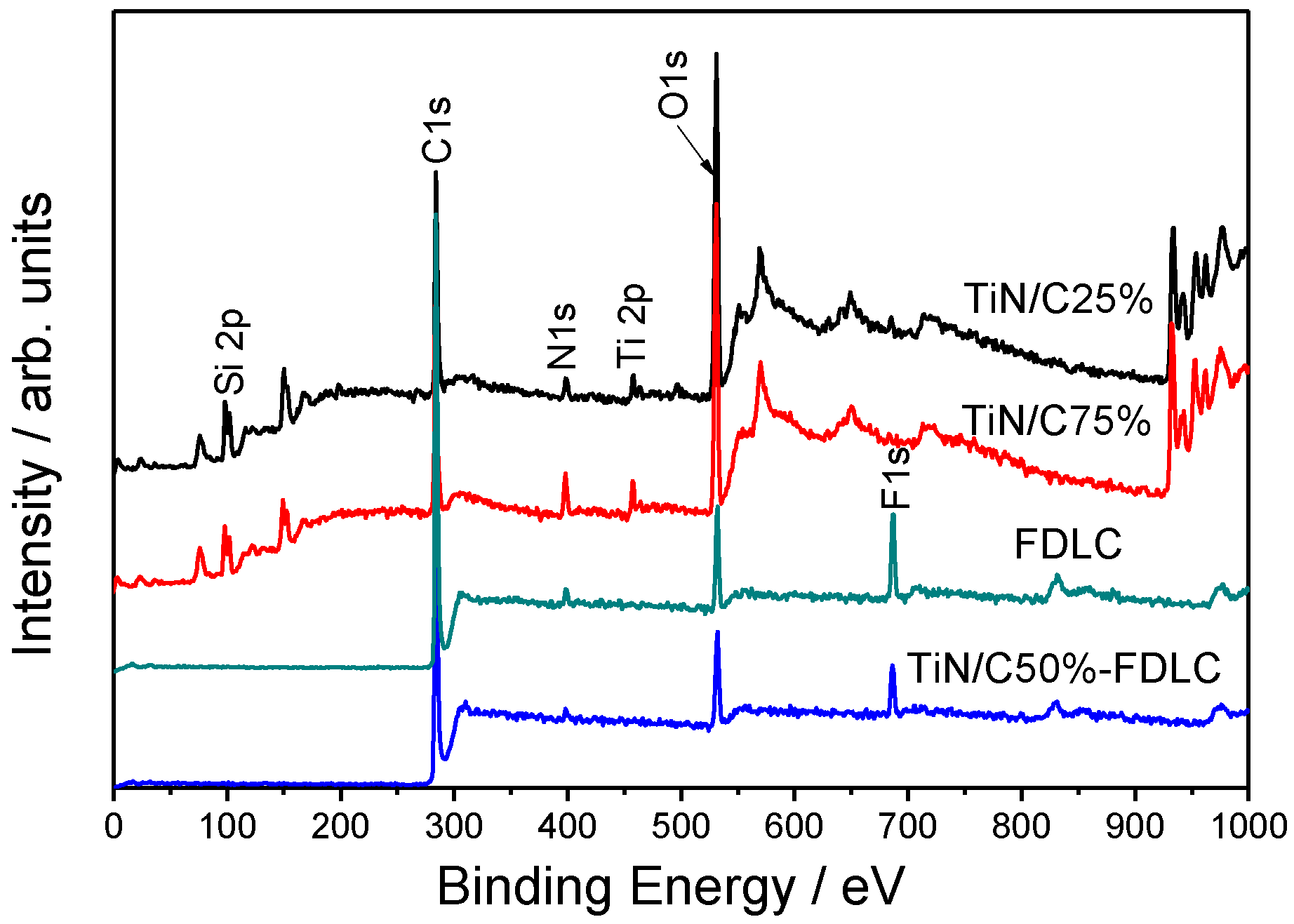
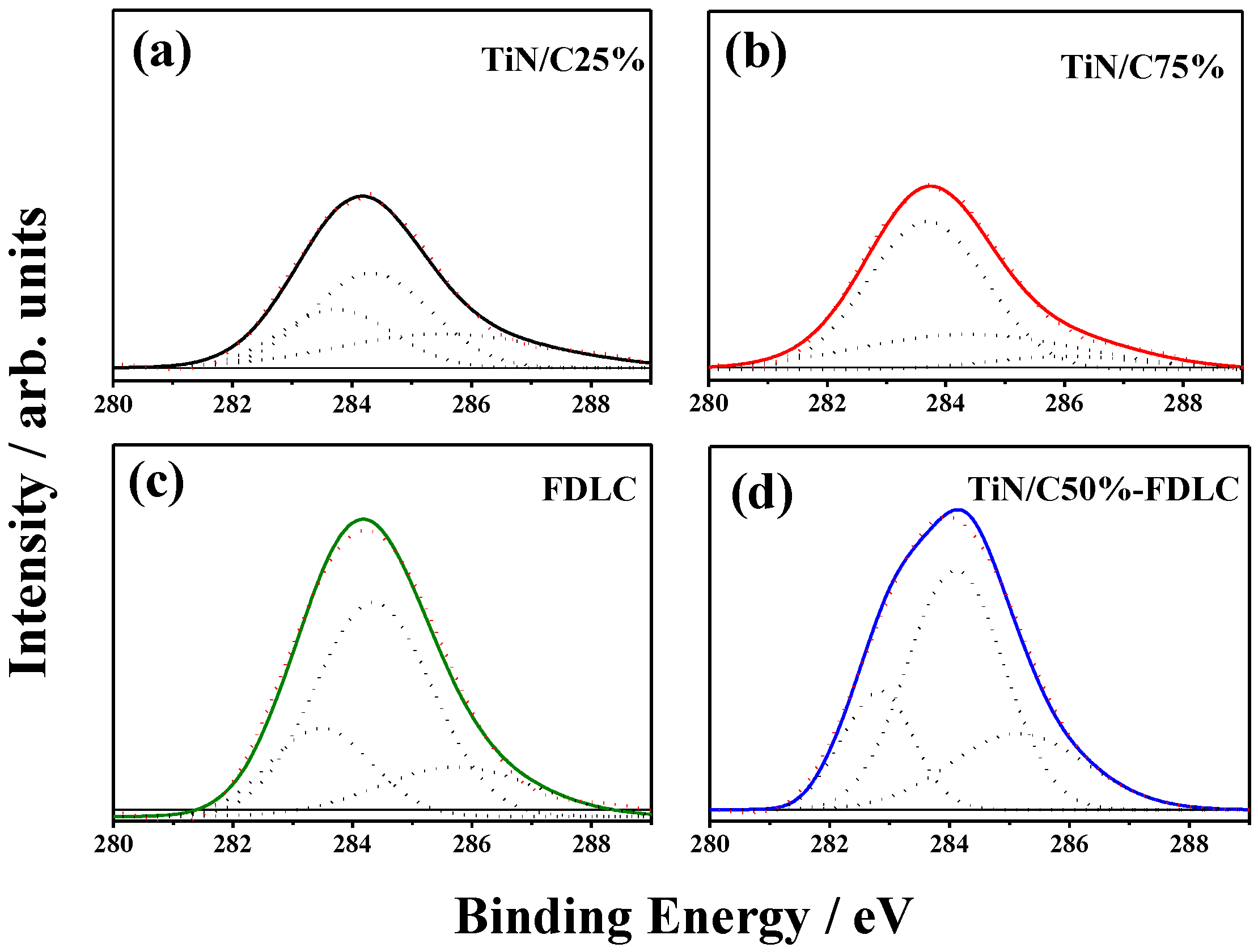
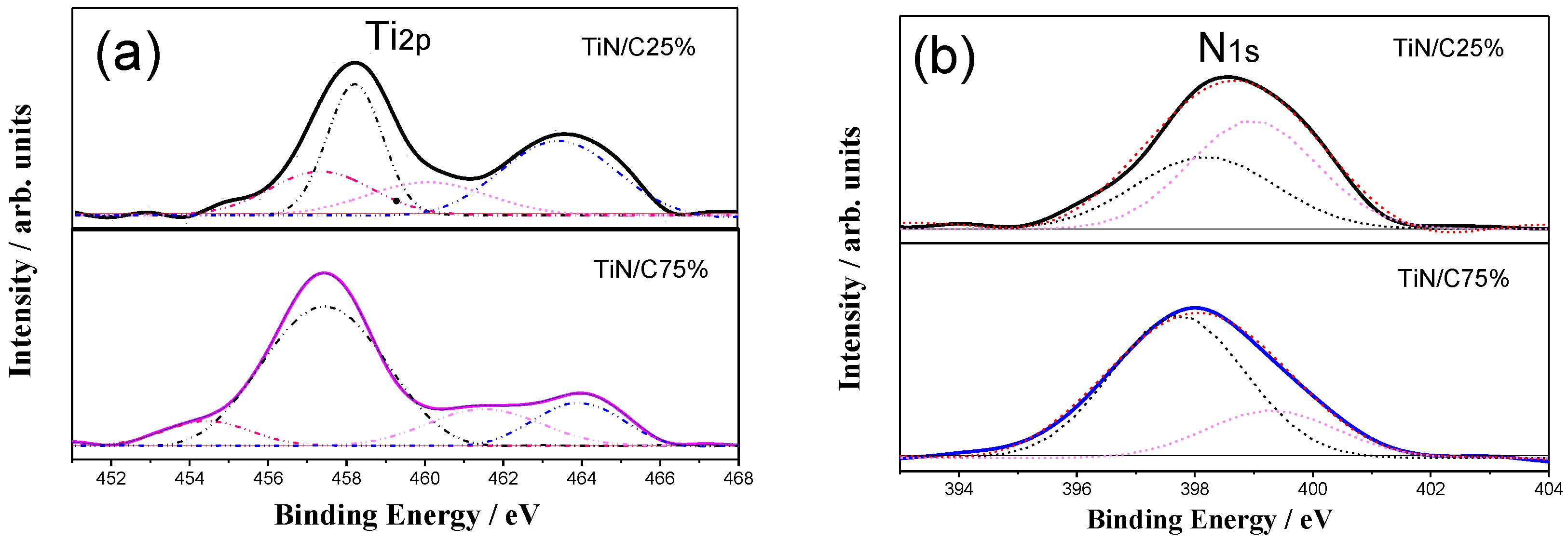
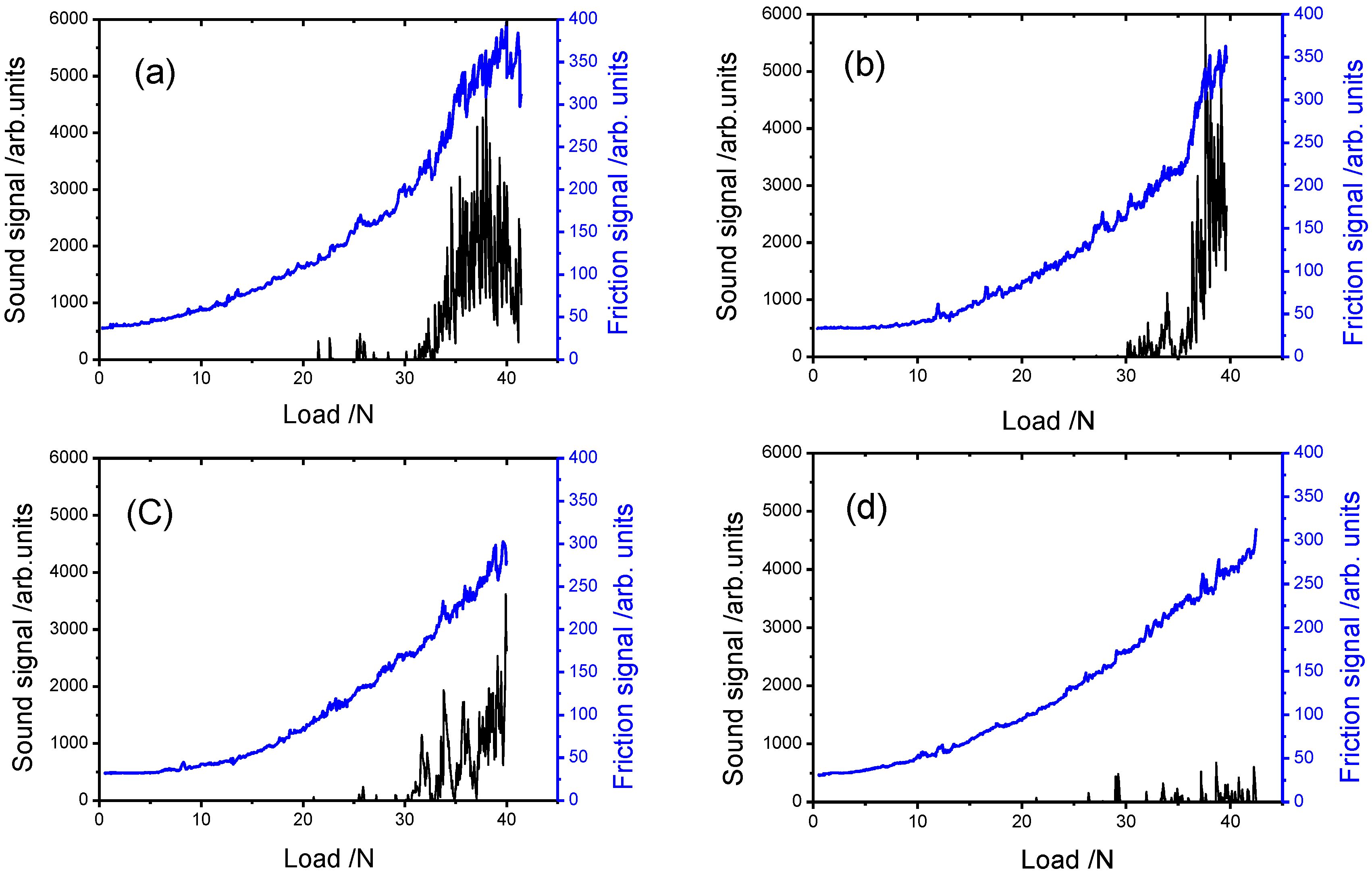
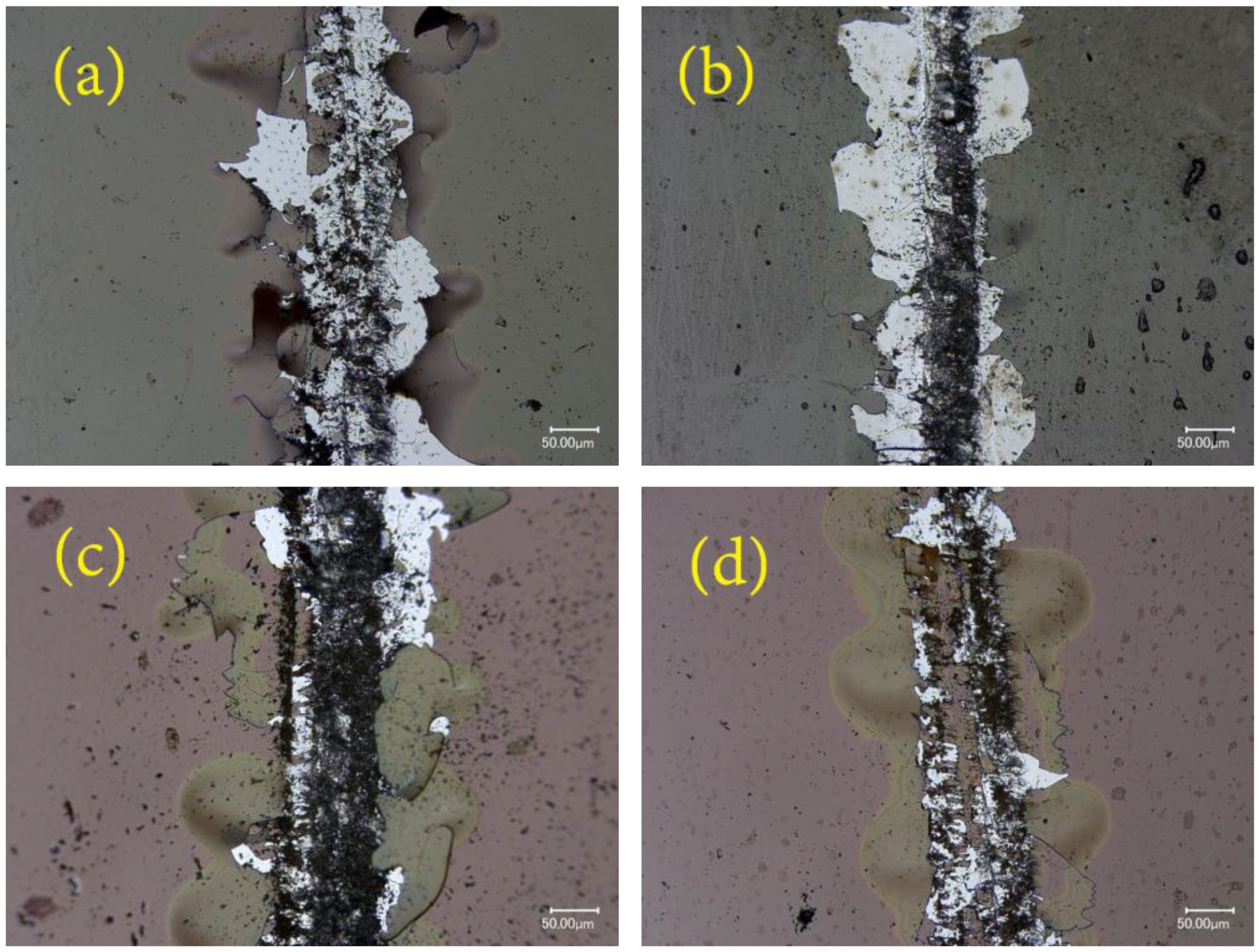
© 2018 by the authors. Licensee MDPI, Basel, Switzerland. This article is an open access article distributed under the terms and conditions of the Creative Commons Attribution (CC BY) license (http://creativecommons.org/licenses/by/4.0/).
Share and Cite
Xiao, J.; Gong, C.; Qi, M.; Jiang, A.; Wang, Z.; Li, M.; Ma, J. Effect of TiN/C Microstructure Composite Layer on the Adhesion of FDLC Film onto Silicon Substrate. Coatings 2018, 8, 18. https://doi.org/10.3390/coatings8010018
Xiao J, Gong C, Qi M, Jiang A, Wang Z, Li M, Ma J. Effect of TiN/C Microstructure Composite Layer on the Adhesion of FDLC Film onto Silicon Substrate. Coatings. 2018; 8(1):18. https://doi.org/10.3390/coatings8010018
Chicago/Turabian StyleXiao, Jianrong, Chenyang Gong, Meng Qi, Aihua Jiang, Zhiyong Wang, Ming Li, and Jiafeng Ma. 2018. "Effect of TiN/C Microstructure Composite Layer on the Adhesion of FDLC Film onto Silicon Substrate" Coatings 8, no. 1: 18. https://doi.org/10.3390/coatings8010018
APA StyleXiao, J., Gong, C., Qi, M., Jiang, A., Wang, Z., Li, M., & Ma, J. (2018). Effect of TiN/C Microstructure Composite Layer on the Adhesion of FDLC Film onto Silicon Substrate. Coatings, 8(1), 18. https://doi.org/10.3390/coatings8010018




